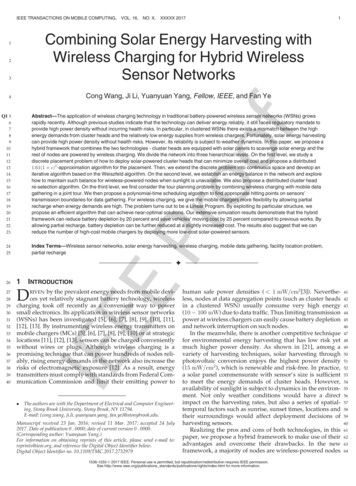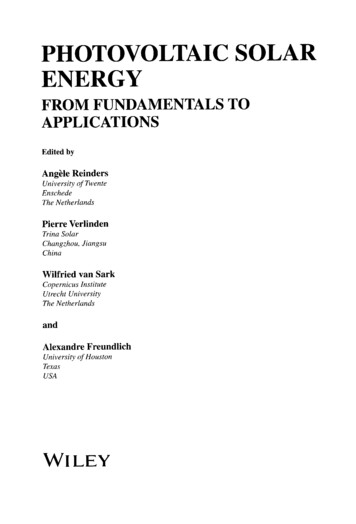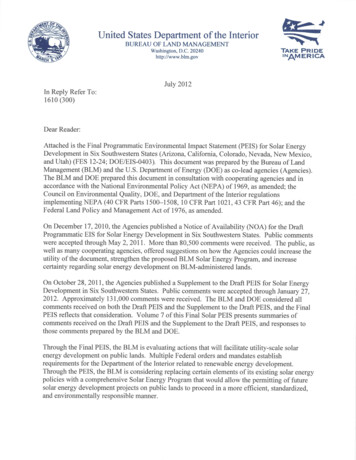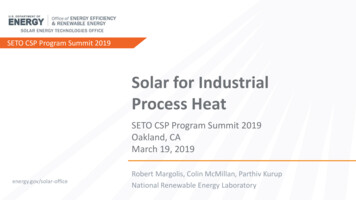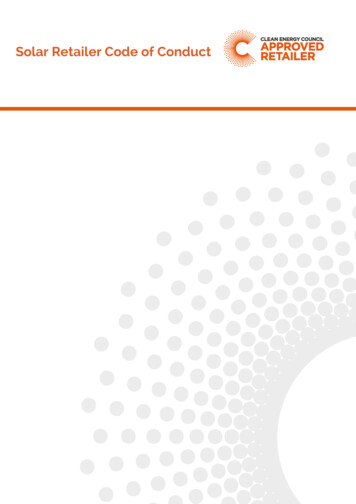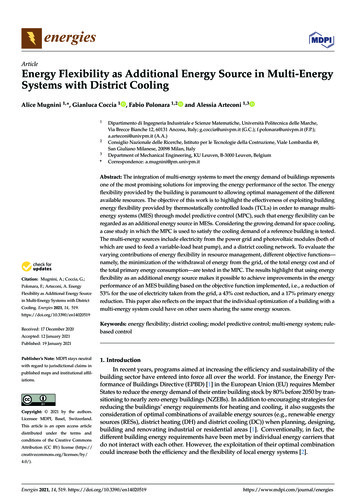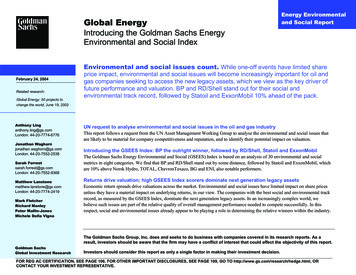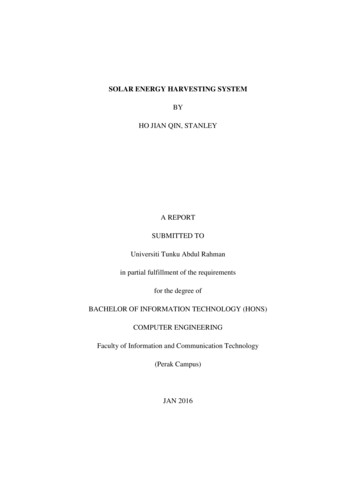
Transcription
SOLAR ENERGY HARVESTING SYSTEMBYHO JIAN QIN, STANLEYA REPORTSUBMITTED TOUniversiti Tunku Abdul Rahmanin partial fulfillment of the requirementsfor the degree ofBACHELOR OF INFORMATION TECHNOLOGY (HONS)COMPUTER ENGINEERINGFaculty of Information and Communication Technology(Perak Campus)JAN 2016i
UNIVERSITI TUNKU ABDUL RAHMANREPORT STATUS DECLARATION FORMTitle:Academic Session:I(CAPITAL LETTER)declare that I allow this Final Year Project Report to be kept inUniversiti Tunku Abdul Rahman Library subject to the regulations as follows:1.The dissertation is a property of the Library.2.The Library is allowed to make copies of this dissertation for academic purposes.Verified by,(Author’s signature)(Supervisor’s signature)Address:Supervisor’s nameDate:Date:ii
SOLAR ENERGY HARVESTING SYSTEMByHo Jian Qin, StanleyA REPORTSUBMITTED TOUniversiti Tunku Abdul Rahmanin partial fulfillment of the requirementsfor the degree ofBACHELOR OF INFORMATION TECHNOLOGY (HONS)COMPUTER ENGINEERINGFaculty of Information and Communication Technology(Perak Campus)JAN 2016iii
DECLARATION OF ORIGINALITYI declare that this report entitled “SOLAR ENERGY HARVESTING SYSTEM” is my ownwork except as cited in the references. The report has not been accepted for any degree andis not being submitted concurrently in candidature for any degree or other award.Signature :Name :Date :iv
ACKNOWLEDGEMENTSI would like to express my sincere biggest gratitude and appreciation to my supervisor, Mr.Lee Wai Kong who has given me this bright opportunity to research and design a new solarharvesting system. A million thanks to you for your endless measure in guidance, supportand patience.To a very special person in my life, Nadia See, for her patience, unconditional love andsupport, and for standing by my side during hard times. I would like to give thanks to myparents and my family for their love, support and continuous encouragement throughout theentire course of study.Finally, I must say thanks to everyone who has supported me financially even during harshtimes.v
ABSTRACTThis project is to study and build a solar energy harvesting system for academic, researchand development purpose. This project focuses on how to harvest solar energy moreefficiently and effectively. In this project energy of light from the sun will be harvestedusing solar panels and the thermal energy from the sun using thermoelectric generators(TEC). That way both photovoltaic effect and Seebeck effect will be used to produceelectricity. The solar panels and TECs will be attached to a 5V DC-to-DC converter toregulate the output to 5V. One side of the TEC would have to be exposed to coolertemperatures in order to obtain better results hence the whole system would be placed inwater such as ponds, pools, etc. Water propellers will be integrated into the system so thatthe system will be able to be manoeuvred on water. This system will consist of five majorcomponents, which are the solar panels, the TECs, microcontroller, water propellers, and afloatation device. Two Arduino Uno microcontrollers are used in this project. One will beattached to the system and the other will be connected to the remote control. Bothmicrocontrollers will have 2.4GHz NRF24L01 (wireless transceiver/receiver modules)attached to them to enable wireless communication. The microcontroller will be used toperform data logging during the early stages of this project. The expected outcome of theproject is to be able to use the constructed system to charge batteries and being able to bemanoeuvred on water and perform data logging via wireless communications.vi
TABLE OF CONTENTSFRONT COVERiREPORT STATUS DECLARATION FORMiiTITLE PAGEiiiDECLARATION OF ORIGINALITYivACKNOWLEDGEMENTSvABSTRACTviTABLE OF CONTENTSviiLIST OF DIAGRAMSxLIST OF FIGURESxiiLIST OF TABLESxivLIST OF SYMBOLSxvLIST OF ABBREVIATIONSxviCHAPTER 1 INTRODUCTION11.1 Problem Statement11.2 Background information and motivation11.3 Objectives21.4 What have been achieve3CHAPTER 2 LITERATURE REVIEW42.1 Literature Review42.1.1 Solar Panels (Solar cells)42.1.2 Monocrystalline and Polycrystalline solar panels7vii
2.1.3 Thin-Film Solar Cells (TFSC)82.1.4 Thermoelectric generator (TEG)92.1.5 Thermoelectric Fan Powered by a Candle102.1.6 NOMAD 7 solar panel112.3 Critical Remarks of previous worksCHAPTER 3 SYSTEM DESIGN12133.1 Design and implementation of the TEC system133.1.1 Connecting the TEC module to heat-sinks143.1.2 Assemble Arduino to perform data logging143.1.3 Design and assemble a complete TEC system18with multiple TECs3.1.4 Wire the TECs together in parallel and perform data logging183.1.5 Wire the TECs together in series and perform data logging213.1.6 Comparing both connection methods233.1.7 Adding finishing touches to the TEC system243.2 Design and Implementation of the solar cell system3.2.1 Research and perform data logging for different2425kind of solar panels3.2.2 Compare and determine which type of solar panel is suitable273.2.3 Data logging to determine the amount of solar panels to use273.2.4 Assembling of the solar cell system283.3 Integration of the two the system onto a floatation device28viii
3.4 Testing of floatation device of the completed system43CHAPTER 4 WIRELESS COMMUNICATION USING ARDUINO44CHAPTER 5 CONCLUSION505.1 Project Review, Discussions and Conclusions505.2 Future work51REFERENCE52ix
LIST OF DIAGRAMSDiagrams NumberTitlePageDiagram 3.1Block diagram of the design flow of the TEC13systemDiagram 3.2Block diagram of how the TECs are21connectedDiagram 3.3Block diagram of the design flow of the Solar24systemDiagram 3.4Block diagram of the connections for solar panel25Data logging circuitDiagram 3.5Block diagram of the connections between Solar27Panels and DC-to-DC converterDiagram 3.6Block diagram of the connections to combine29TEC system with Solar cell systemDiagram 3.7Block diagram of the assembled solar energy32harvesting systemDiagram 3.8Block diagram of the connections for33data logging between TEC system andArduino (COM17)Diagram 3.9Block diagram of the connections for33data logging between solar panel andArduino (COM17)Diagram 3.10Block diagram of connections between35Funduino, Arduino and NRF24L01 x
LIST OF DIAGRAMSDiagrams NumberTitlePageDiagram 3.11Block diagram of connections between41Arduino (COM17), ESC, Motors andportable battery bankDiagram 4.1Block diagram of connections between44Arduino (COM18) and NRF24L01 xi
LIST OF FIGURESFigures NumberTitlePageFigure 2.1Solar panels on houses4Figure 2.2Components of a solar panel5Figure 2.3Figure of how solar cell works6Figure 2.4Monocrystalline solar panel7Figure 2.5Polycrystalline solar panel7Figure 2.6Thin-Film solar panel8Figure 2.7Thermoelectric generator9Figure 2.8Thermoelectric fan powered by candles10Figure 2.9NOMAD 7 solar panel11Figure 3.1Single TEC with heat sinks14Figure 3.2Verification test with AAA battery16Figure 3.3Verification test on LCD17Figure 3.4Figure of TEC for data logging17Figure 3.5Figure of TEC with temperature reader19Figure 3.6Graph of Power VS Temperature of TEC System19wired in parallelFigure 3.7TEC system with boiling pot20Figure 3.8Graph of Power VS Temperature of TEC System21wired in parallel with boiling potFigure 3.9Graph of Power VS Temperature of TEC System22wired in seriesFigure 3.10Graph of Power VS Temperature of TEC System23wired in series with boiling potFigure 3.11Assembled TEC system24Figure 3.12Floatation platform30xii
LIST OF FIGURESFigures NumberTitlePageFigure 3.13Floatation platform with Styrofoam31Figure 3.14Assembled Solar energy harvesting system31Figure 3.15Assembled Solar energy harvesting system34with data logging circuitsFigure 3.16Arduino with Funduino35Figure 3.17Arduino serial page42Figure 3.18Solar energy harvesting system on water43Figure 4.1Arduino with NRF24L01 and capacitors45Figure 4.2Arduino software48Figure 4.3Arduino serial page49xiii
LIST OF TABLESTables NumberTitlePageTable 3.1Connections between LCD and Arduino15Table 3.2Data of TEC system’s output wired in parallel19Table 3.3Data of TEC system’s output wired in parallel20with boiling potTable 3.4Data of TEC system’s output wired in series22Table 3.5Data of TEC system’s output wired in series23with boiling potTable 3.6Data of 5V solar panel’s output26Table 3.7Data of 3 20V solar panel’s output with28DC-to-DC converterTable 3.8Data of TEC system’s output wired in series30with boiling pot and DC-to-DC converterxiv
LIST OF SYMBOLSVVoltageGHzGiga Hertz United State Dollars%Percentage ToWWattsLbsPoundsmAhmilli ampere per hourmAmilli ampereuFmicro faradICurrentAAmpereRResistanceΩOhmxv
LIST OF ABBREVIATIONSCPUCentral processing unitUSBUniversal Serial BusTECThermoelectric coolerPVPhotovoltaicsTEGThermoelectric generatorU.S.United StatesTFSCThin Film Solar CellsLCDLiquid Crystal Display2DTwo-DimensionDC-to-DCDirect current to direct currentxvi
CHAPTER 1: INTRODUCTION1.1 Problem StatementMany countries around the world are still using fossil fuels to generate electricity.Not only they are depleting resources, they also cause a lot of pollution to the environment.Although it is still cheap to use fossil fuels to generate electricity now, it will eventuallycost a fortune when the world’s fossil fuel starts to deplete. Hence why more studies andresearches should be done on renewable energy such as solar energy, wind energy, andmore as they will be the best source of energy when fossil fuel are depleted.Not only renewable energy is unlimited, it is also pollution free. The only downsideis that some renewable energy system is not very efficient. Another problem is that solarpanels are usually installed to a fixed location and sometimes it will be sheltered by objects.Hence in this project I would like to develop a solar energy harvesting system that floatsand able to manoeuvre around water. It will utilize both TEC and Solar panels to generateeven more electricity compared to the conventional solar harvesting energy system whichonly utilizes solar panels.Generally, most of the clean energy harvesting system are stationary and requiresconstant maintenance / monitoring. This project might be the answer to self-sustainabilityclean energy that it both portable and easy to manoeuvre.1.2 Background information and motivationSolar panels are composed of a number of solar cells that converts energy obtainedfrom light into electricity also known as Photovoltaics (PV). As long as there is directsunlight towards the solar panels, it will produce electricity. Solar cells were invented backin 1839 and were inefficient and expensive to produce at the time. As of now, solar panelsare cheaper to produce and are more efficient compared to the past.TECs are small devices that can converts temperature differences directly intoelectricity, also known as the Seebeck effect. The device basically consists of two sides, onewould be exposed to heat and the other side will be exposed to cooler temperatures. Thesedevices were discovered in the 19th century and only in recent years have been put to good1
use. TECs are used in gas pipelines, automobiles, etc. TECs only generate a small amountof electricity under normal circumstances.The amount of electricity produced from the solar panels themselves are fairlysmall, hence almost every solar harvesting system consist more than 1 solar panel in theirsystem.The Arduino Uno is a programmable microcontroller that needs an input of 5V inorder to function. It can be used in many ways by attaching more components to themicrocontroller.With the current market on fossil fuels being unstable, one can only predict that itmight come to a day that fossil fuels are either too expensive to be used or too hard to beobtained. With solar panels and TEC being easily accessible and cheap to obtain in this era,it is a great time to be researching on clean self-sustainability solar energy harvestingprojects that is both efficient and portable.1.3 ObjectivesThe main objective of this project is to improve the effectiveness and efficiency of solarenergy harvesting. Below are the sub-objectives that are aimed to be achieved in thisproject.-Produce better results than the conventional solar energy harvesting system.-Optimizing the TECs to produce better results.-To integrate TECs and solar panels together into one system.-To install floatation device onto the system.-Able to perform data logging wirelessly.-Install necessary components to allow the system to be manoeuvred via wirelessremote.-To be able get harvest more electricity than electricity consumption.We are only going to use natural heat and cold to power up the TECs as using artificial heatand cold will destroy the purpose of renewable energy harvesting.2
1.4 What have been achieveBelow are the highlights of what have been achieved in this project so far.-Data collection of how much energy the TECs and Solar panels collect.-Building a TEC system consisting of 7 TECs and heat sinks attached to both sides withcharging output capability. (Attached to a 5V DC-to-DC converter)-Merging of the two solar energy harvesting systems onto a floatation platform.-Able to charge and discharge electricity at the same time.-Being able to communicate with the system via wireless communication using ArduinoUno R3.-Able to perform data logging via wireless communication-Programming of the two Arduino devices to control underwater motors of the solarenergy harvesting system.-Able to harvest more energy than discharging rate-The entire system is able to float on water3
CHAPTER 2: LITERATURE REVIEW2.1 Literature Review2.1.1 Solar Panels (Solar cells)There are a few systems that have been created to harvest solar energy and convertthem into electricity to power up household appliances or industrial level appliances. One ofthe most commonly known systems is solar panels. The practical solar cells that are used tocreate solar panels were invented in the 1950’s by a few companies. Back then s
clean energy that it both portable and easy to manoeuvre. 1.2 Background information and motivation Solar panels are composed of a number of solar cells that converts energy obtained from light into electricity also known as Photovoltaics (PV). As long as there is direct sunlight towards the solar panels, it will produce electricity. Solar cells were invented back in 1839 and were inefficient and expensive to
